Title: "Is Solana's Inflation Too High?"
Author: Lostin
Translation: zhouzhou, BlockBeats
Editor's Note: The issue of inflation on the Solana network has sparked widespread discussion in recent years. Currently, the inflation rate of the Solana network is approximately 5.07%, while the network's staking rate has reached as high as 65%. In the inflation model, users receive rewards through validation nodes, while the circulating supply of tokens gradually decreases over time. Although Solana's staking rewards are attractive, there is still uncertainty about the long-term impact of its inflation on token prices. Future adjustments to the inflation plan, such as reducing the issuance or changing the inflation mechanism, may further affect the network's sustainability and economic model.
The following is the translation of the original article:
Operational Methodology:
All SOL tokens come from two sources: the genesis block or protocol inflation (also known as staking rewards). Conversely, transaction fee burning is the only protocol mechanism that can remove SOL tokens from circulation.
Token issuance is described by three key parameters of the inflation plan: initial inflation rate (8%), deflation rate (-15%), and long-term inflation rate (1.5%). Solana's mainnet inflation officially started on the 150th epoch on February 10, 2021. The current inflation rate is 5.07%.
Proof of Stake (PoS) inflation leads to a decrease in the network share of non-stakers relative to stakers, effectively transferring wealth from non-stakers to stakers.
Solana's staking rate is 65%, which is relatively high compared to other networks in the industry. The total staked amount is currently 380 million SOL, and this quantity has remained relatively stable since the 202nd epoch in July 2021. In most epochs, there are seven-figure SOL staking and unstaking activities.
Key variables in calculating staking rewards are the inflation rate and the percentage of staked SOL. Nominal Staking Yield (NSY) can be calculated using the following formula: NSY = inflation rate * validator uptime * (1 - validator commission) * (1 / SOL staking percentage).
As of December 14, 2023, the total burning fee exceeded 1% of staking rewards for the first time, reaching a peak of 7.8% in March. In the most recent 100 epochs, fee burning has averaged 3.2% of total staking rewards. After the implementation of SIMD-96, the deflationary pressure from burning tokens will become negligible.
In many jurisdictions globally, receiving inflation rewards in additional token form is considered a taxable event, which may lead to selling pressure due to tax obligations. This impact is difficult to quantify.
Proof of Stake (PoS) inflation leads to sustained downward pressure on prices in the long term, distorting market price signals and hindering fair price comparisons.
Independent validators and ecosystem team validators often exhibit lower staking reward commission rates and rely less on inflation commissions than other validator groups, including exchanges and institutional validators.
Since December 2023, alternative sources of income for validators (including MEV commissions and block rewards) have significantly increased. This growth provides a potential pathway for sustainable validator groups in the future, reducing their reliance on inflation commissions for operational expenses. However, whether these alternative income sources can be maintained at a high level in the long term remains to be seen.
Introduction
This report provides a comprehensive analysis based on data and facts, aiming to clarify doubts (FUD) and misinformation surrounding Solana's inflation plan. The analysis is divided into three parts: past, present, and future.
Past: Reviews the token economy of Solana before inflation, detailing key events such as token sales, unlocks, and early token burning.
Present: Quantitatively evaluates the current inflation plan and deflationary factors, including transaction fee burning, punitive reductions, user-related losses, and rent. It also discusses the potential impact of the upcoming SIMD-96 protocol update.
Future: Explores arguments for and against the current Proof of Stake (PoS) inflation rate on Solana and considers potential adjustments to the existing inflation plan.
Important Definitions
First, we will formally define several important terms that will be used in this report. Readers familiar with these Solana-specific definitions can skip this section.
Total Current Supply: The total amount of existing SOL tokens, including locked and unlocked tokens. More professionally, the current total supply is equal to the total generated token amount minus the total burned token amount. At the time of writing, the current total supply is 583 million.
Circulating Supply: The total amount of SOL tokens circulating in exchanges, on-chain protocols, and user wallets, including staked and unstaked SOL. The circulating supply is 466 million. More formally:
Circulating Supply = Current Total Supply - Non-Circulating Supply
Non-Circulating Supply: The non-circulating supply mainly includes two forms: locked SOL tokens in staking accounts and unlocked staking accounts held by Solana Labs or Solana Foundation. The SOL in staking accounts is usually due to SOL investments or grants provided by Solana Foundation. Each staking account has an unlock date set according to the ownership arrangement. Secondly, SOL tokens directly owned by Solana Labs or Solana Foundation, which are held in unlocked staking accounts. The foundation currently uses a large portion of these (currently 51 million SOL) for its delegation program. At the time of writing, the non-circulating supply is 117 million.
Locked Tokens: Locked tokens refer to tokens held in staking accounts with conditions set that prevent withdrawal until a specified date. These lock parameters are based on specific UNIX timestamps or epochs set by designated custodians when creating the accounts. Locked staking accounts can be undelegated, split into smaller accounts, and redelegated to other validators. However, these tokens cannot be withdrawn or transferred to other addresses until the lock period expires. While any user can create locked staking accounts, this practice is primarily used by Solana Foundation for token distribution and grants, which typically come with specific performance requirements or time locks.
Past: Pre-Inflation and Early Token Economics
On March 16, 2020, 500 million SOL tokens were generated in the genesis block of the Solana mainnet Beta cluster. During its first year of operation, Solana did not have inflationary staking rewards. On March 24, 2020, 8 million SOL tokens were sold to non-US buyers through a Dutch auction on CoinList. The auction raised only $1.76 million, with a final clearing price of $0.22 per token. The tokens from this public auction, along with a small amount distributed through a series of airdrop activities on Binance, constituted the initial circulating supply of Solana.
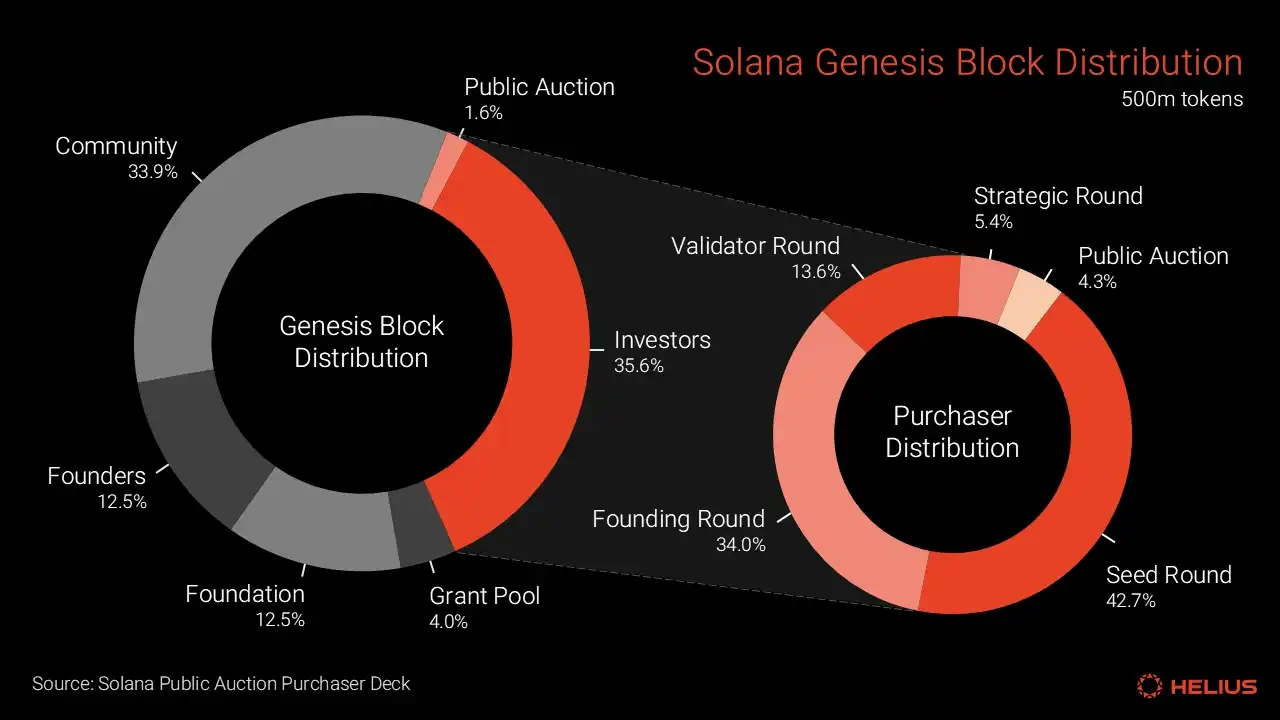
Solana Genesis Block Allocation Chart, excerpted from the original public auction buyer's documentation
During this period, Solana faced significant challenges in raising funds compared to many of its peers in the industry. For example, Algorand successfully raised $60 million through a similar CoinList auction six months earlier, while Hedera Hashgraph raised $100 million from institutional and high-net-worth individual investors eighteen months prior.
"Before we went live in 2020, we tried to raise more bridge round funds, but we failed. To extend the use of funds, we had to cut a third of the team. We went live as soon as possible in March, and the pressure was immense… We announced the auction, and two days later, on March 16, 2020, all markets crashed. The world was in chaos, and we had only six to seven months of funds left."
This period of funding shortage shaped many important early decisions.
"This forced me to take a specific strategy, which in hindsight was the right one… If we had as much funding as our competitors, I might have followed in their footsteps, supporting EVM; we had to support EVM… It turns out, the best decision we could make was to build a runtime purely for performance optimization."
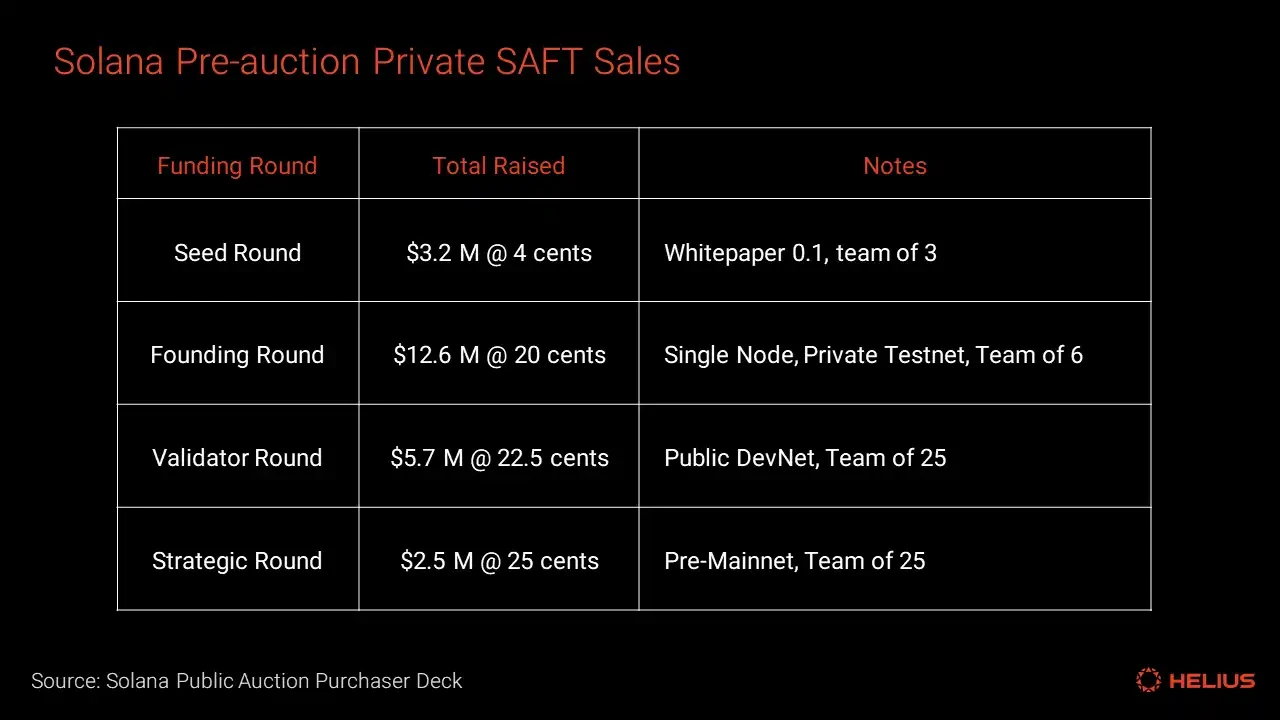
Pre-auction private SAFT sale (source)
Approximately nine months after the auction, early token holders from the pre-auction private SAFT sale (seed round, founding round, strategic round, and validator round) had all their tokens unlocked. The founding team members unlocked 50% of their tokens, with the remaining 50% unlocking gradually over the next 24 months. Tokens of non-founding employees also unlocked at this time (100%), but with undisclosed sales restrictions.
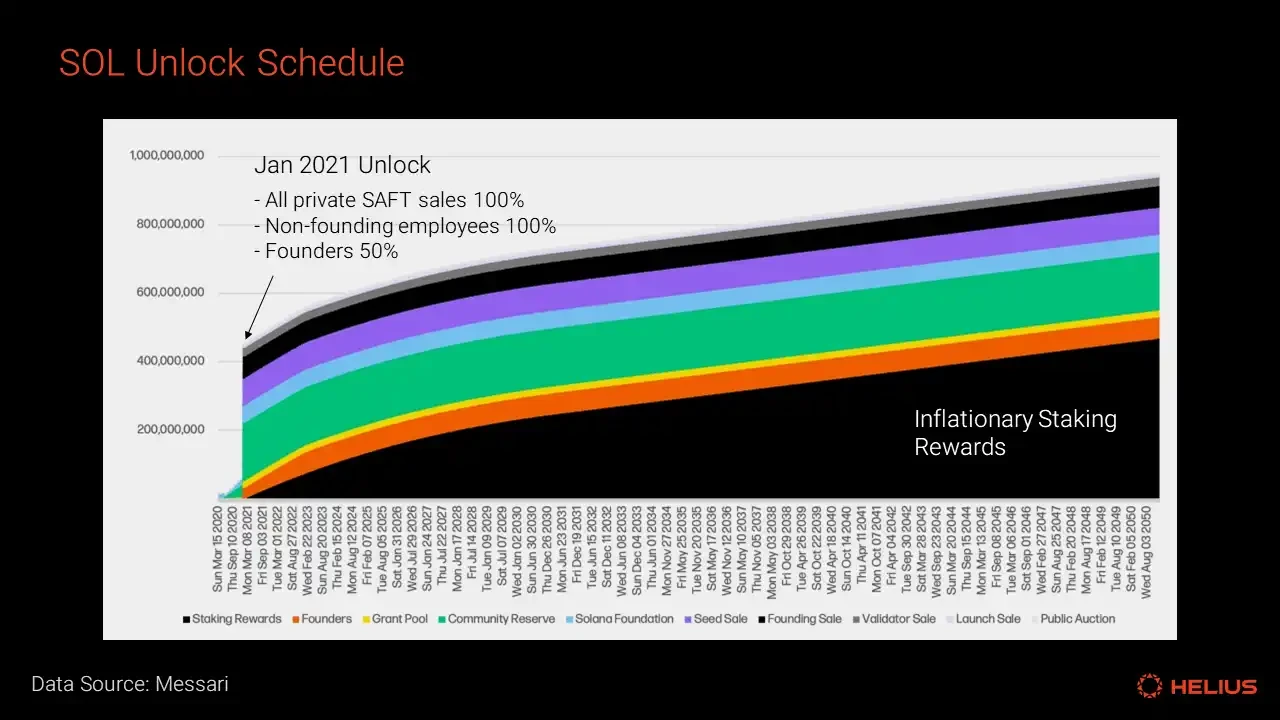
Solana's unlocking schedule
In May 2020, in response to early community concerns about lending tokens to market makers, the Solana Foundation permanently removed 11.36 million SOL from its holdings, reducing the total supply to 488.64 million.
Present: Solana's Inflation Plan
According to community voting, the inflation on the Solana mainnet Beta officially started on February 10, 2021, at slot 64800004 (epoch 150), paying out 213,841 SOL for the first time.
The inflation plan is a deterministic description of the token issuance schedule, including three key parameters:
Initial inflation rate (8%): The starting inflation rate when inflation first starts
Deflation rate (-15%): The rate of decrease in inflation rate per epoch year
Long-term inflation rate (1.5%): Stable long-term expected inflation rate
At the time of writing, Solana's inflation rate is 5.07%. This can be checked using the "solana inflation" command in the Solana CLI tool suite or the "getInflationRate" RPC method.
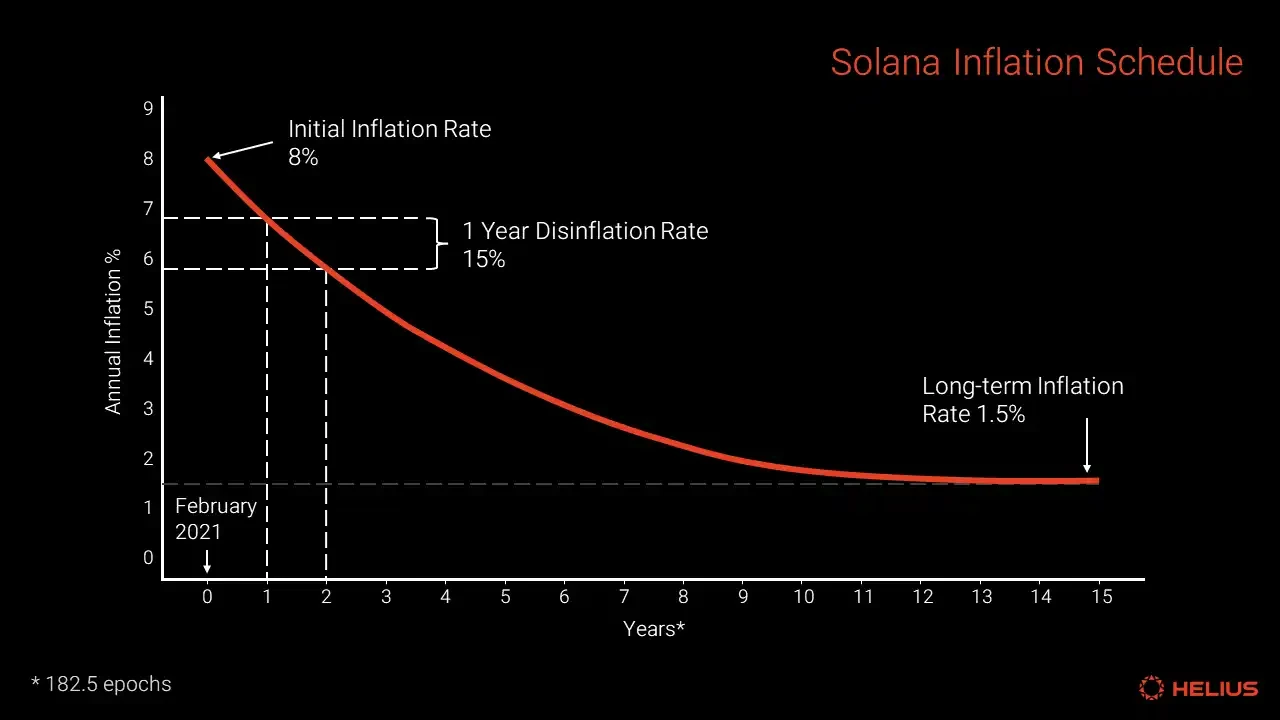
Solana's Inflation Plan (Source)
An epoch year consists of 182.5 epochs, which is the number of epochs in a year when each epoch lasts exactly two days. An epoch consists of 432,000 slots, with each slot's minimum duration being 400 milliseconds. However, due to the variable block time, epochs typically extend beyond the minimum two-day limit, sometimes by several hours (for example, recent epoch 661 lasted 2 days 4 hours). In earlier years, the Solana mainnet cluster often experienced slower three-day epochs (for example, epoch 322 lasted 3 days 3 hours), significantly extending the progress of the inflation plan when measured in standard years.
For example, as of August 30, 2024, the current epoch for Solana is 663. This is the 513th epoch since inflation started at epoch 150 on February 10, 2021, equivalent to 2.81 epoch years but spanning 3.55 standard years.
The following chart models the current total supply based on the inflation plan starting from the initial 4.886 billion SOL (5 billion minus 11.3 million burned) in February 2021.
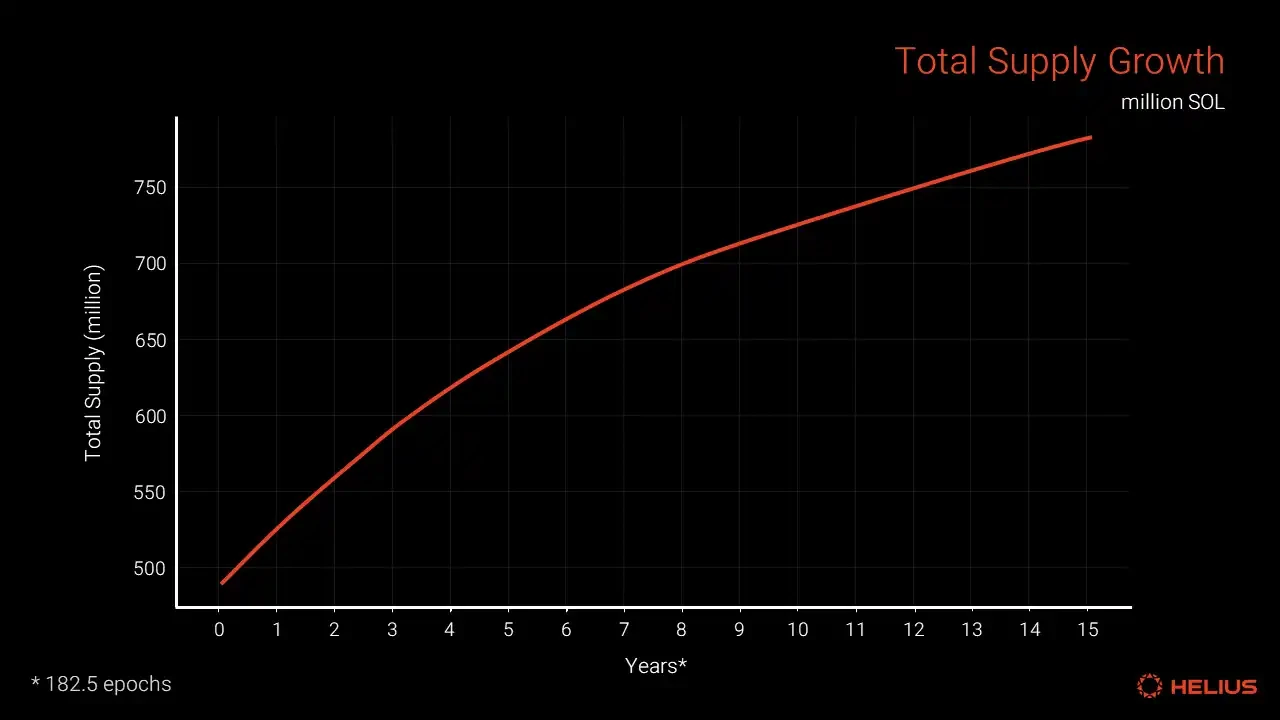
The specific parameters for these choices are no longer accessible from the original community forum discussions. However, at the time, Solana co-founder Anatoly Yakovenko revealed some clues in an interview.
"I don't think the inflation parameters will be much different from Cosmos because our validator set has a lot of overlap with that network, almost the same people. Also, the inflation plan for Cosmos seems to be working fine, so we don't need to experiment. When something works on other networks, we will definitely borrow those ideas."
Additionally, an early outline about staking rewards in the Solana GitHub repository also mentioned the influence of Casper FFG.
Inflation Distribution Mechanism
The Delegated Proof of Stake (DPoS) consensus mechanism is natively integrated into Solana. Users can directly access the staking interface through wallets, ecosystem dApps, and various comparison platforms. Token holders can easily stake SOL to their chosen validators and unstake at the end of each epoch. Additionally, they can delegate tokens to staking pools or purchase Liquid Staking Tokens (LSTs), which is equivalent to staking. Delegating tokens to validators implies trust in the validator but does not grant ownership or control of the tokens to the validator.
Staking rewards are initially divided based on the points earned within an epoch. Whenever a validator votes for a block, and that block subsequently gets confirmed and becomes the final block, the validator earns a point. The validator's total point share (i.e., their points divided by the total points of all validators) determines their corresponding reward percentage. This percentage is also weighted based on the amount staked. If a validator has 1% of the total staked amount and earns points at the average rate, they will receive approximately 1% of the total inflation reward. If their points are above the average, the reward will fluctuate accordingly. Voting points are a quantitative measure of an individual validator's participation and correctness in the consensus process. Validators being offline (i.e., inactive) or out of sync with the chain significantly affect their rewards.
Inflation rewards are calculated and distributed to delegators' staking accounts at the end of each epoch. Due to the allocation for over one million staking accounts, this consumes significant resources, slowing down the network and leading to frequent consensus forks at the end of epochs.
Validators charge a certain percentage of commission for their services, as part of the delegator's inflation rewards. This commission is typically a single-digit percentage but theoretically can be any value between 0% and 100%. There are currently over 200 private Solana validators, whose staked funds may be entirely owned and self-delegated by operational entities. These fully self-staked SOL validators can be identified by their 100% commission rate.
The following formula describes the nominal staking yield from inflation rewards:
Nominal Staking Yield = Inflation Rate * Validator Uptime * (1 - Validator Commission) * (1 / SOL Staked Percentage)
The SOL Staked Percentage is defined as:
SOL Staked Percentage = Total SOL Staked / Current Total Supply
Staking yields fluctuate with the ongoing changes in the inflation rate per epoch, validator performance, and total active staked amount.
For a deeper understanding of Solana's staking mechanism, check out our Helius staking blog article.
Proof of Stake Inflation Model
Anatoly Yakovenko pointed out in the Lightspeed podcast: "The biggest criticism is that Solana's inflation rate is too high, which is a cost to the network. Mathematically, inflation is actually a transfer of value from non-stakers to stakers. It is indeed a cost to non-stakers, but at the same time, it is a benefit to stakers. The market will balance this out in some way."
Overall, Proof of Stake (PoS) inflation reduces the relative network share of non-stakers compared to stakers, and this dilution effectively transfers wealth from non-stakers to stakers. This phenomenon can be demonstrated through a simplified model with the following parameters:
Total token supply: 10,000
Market value: $1 million
Annual inflation reward: 5%
Initial token holders: 6 users, each holding the same amount of tokens
Staking rate: 66% (4 staking users, 2 non-staking users)
This model demonstrates that as inflation occurs, the token holdings of staking users increase relative to non-staking users, leading to a dilution of the non-staking users' share and a redistribution of wealth.
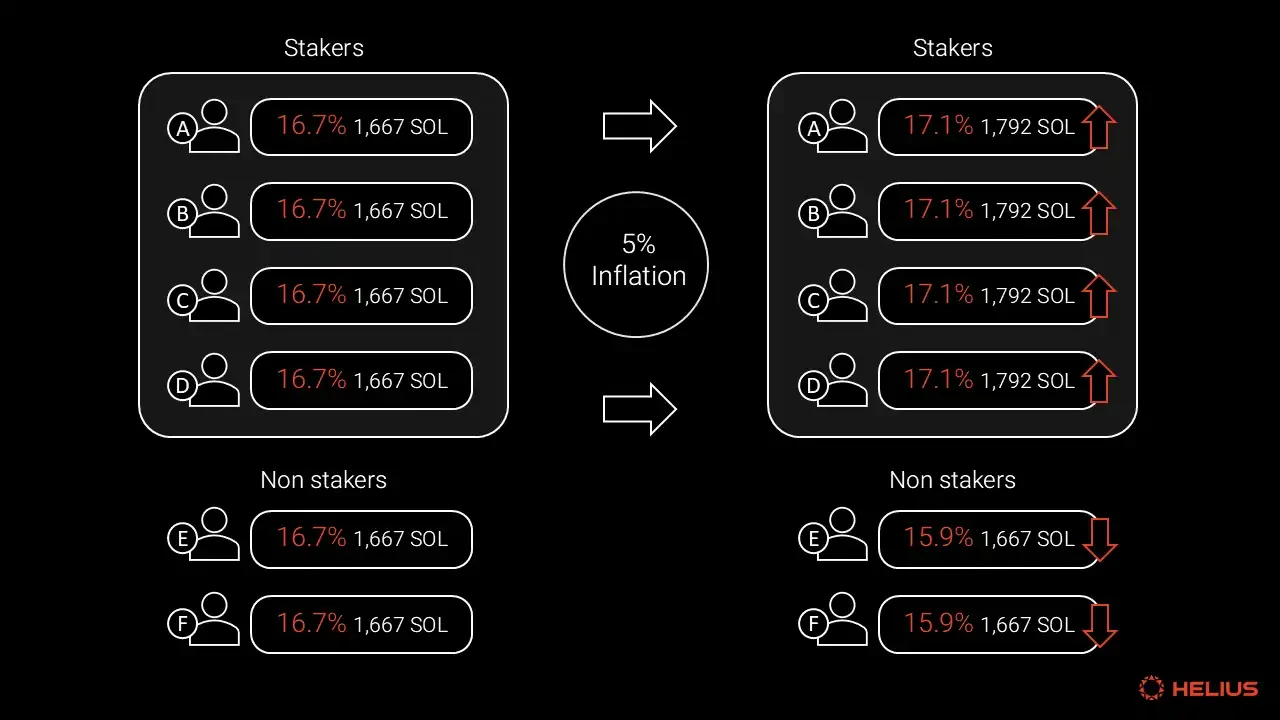
Initially, each user holds 1,667 SOL tokens, representing 16.7% of the network share, with a market value of $166,666. Over the course of a year, 500 new tokens are distributed as inflation rewards to stakers. After one year, each of the four stakers will have 1,792 SOL tokens, nominally increasing by 125 tokens (7.5%), and their network share will grow by 0.4% to reach 17.1%. Meanwhile, the two non-stakers' token holdings remain unchanged, resulting in a decrease of 0.8% in their network share to 15.9%. Assuming the total market value of the network remains at $1 million, the value of each SOL token will decrease from $100 to $95.23. However, the total network share value for each staker will increase by $3,968 (a 2.4% increase). Conversely, the token value for each non-staker will decrease by $7,936 (a 4.8% decrease).
This model demonstrates that Proof of Stake (PoS) staking not only prevents dilution of the share but actually enhances the network ownership of holders over time. Additionally, this simplified scenario accurately reflects the current inflation reward situation in Solana. Solana's current inflation rate is 5.07%, with a total supply of 5.83 billion SOL, of which 3.78 billion SOL are staked (a staking rate of 65%). Users can expect a similar annual value transfer through inflation rewards. Stakers' network ownership is expected to increase by approximately 2.4%, while non-stakers are projected to lose about 4.8% of network ownership. According to this simplified model, stakers should receive a nominal 7.5% SOL staking return annually, which roughly aligns with the current actual return rate. Of course, the actual situation is more complex than this model, and we will discuss it in detail in subsequent discussions.
It is important to note that regardless of the absolute number of tokens held by users, the percentage gain or loss in network ownership is the same. The two key variables are the inflation rate and the percentage of SOL staked.
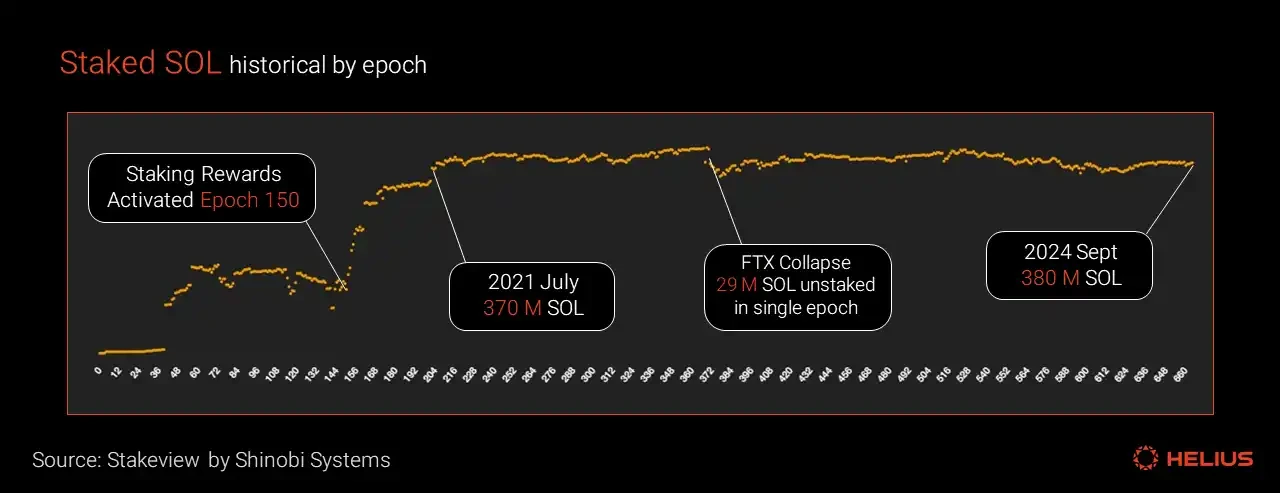
SOL staked amount by epoch since genesis block (source)
Compared to other industry networks, Solana has a relatively high staking rate, partly due to the simplicity and user-friendliness of its staking process. However, since reaching 370 million SOL in epoch 202 in July 2021, the amount of staked SOL has remained relatively stable despite staking rewards leading to inflation of the total supply (as shown in the above chart). This indicates that the SOL staking percentage on Solana is slowly decreasing over time, which is a favorable dynamic for stakers.
Although the overall SOL staked amount remains relatively stable, there are significant fluctuations, with staking and unstaking of SOL typically reaching seven figures in each epoch. These fluctuations are primarily driven by the movement of funds within staking pools.
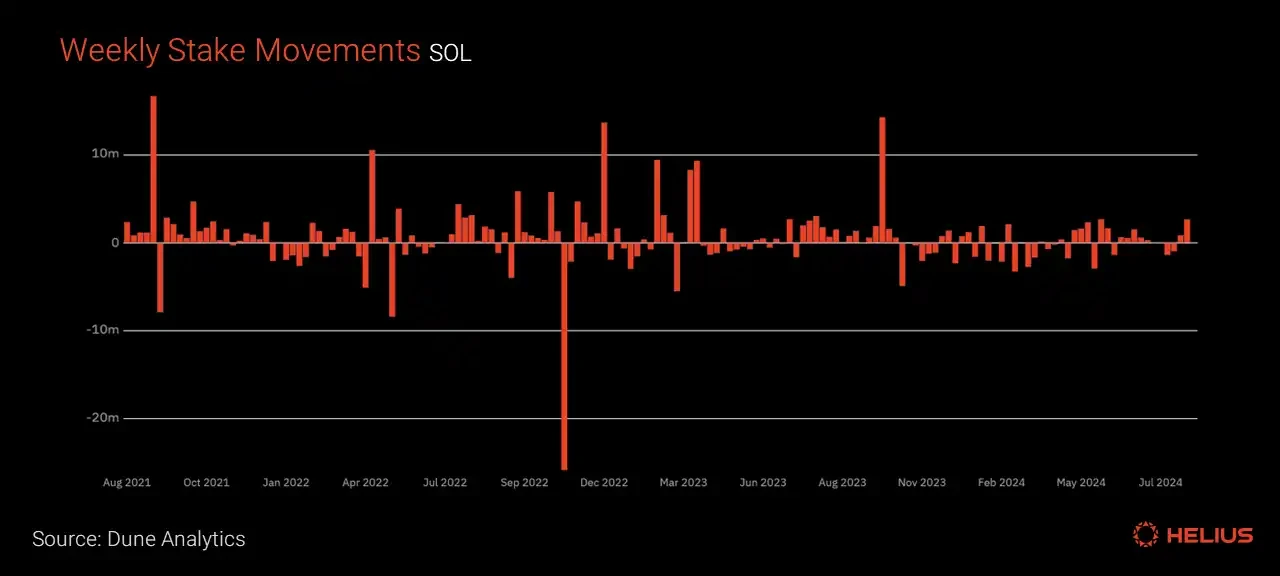
Weekly staking changes (source)
As mentioned earlier, the current SOL staking rate is 65%, with an inflation rate of 5.07%. Assuming the staking rate remains at two-thirds, we can plot charts showing the staking rewards before and after inflation adjustments, displaying nominal and inflation-adjusted returns.
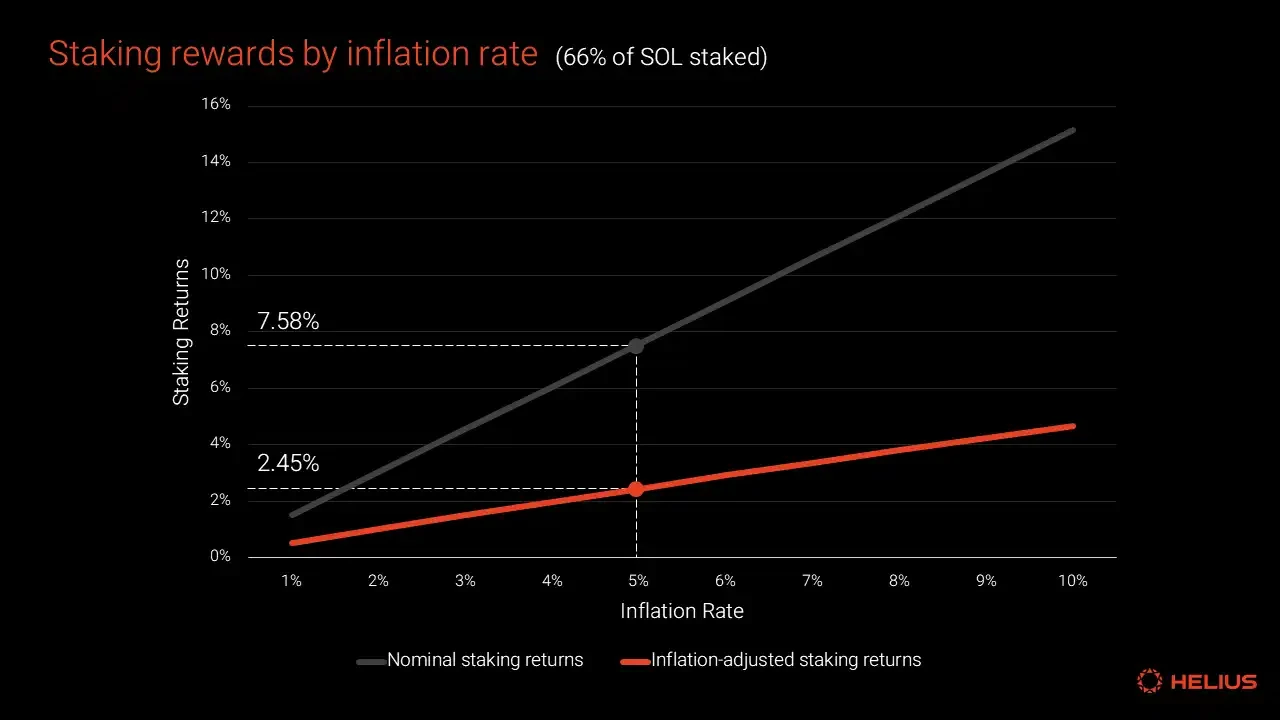
Nominal and inflation-adjusted staking rewards assuming a constant SOL staking rate of 66%
Anti-Inflation Forces
Next, we will analyze Solana's anti-inflation forces, identifying three types: transaction fee burning, punitive reductions, and user-related losses. Additionally, we will consider the impact of Solana's leasing mechanism on inflation. This section introduces the concept of "net inflation," defined as:
Net Inflation = Total Inflation - Total Anti-Inflation
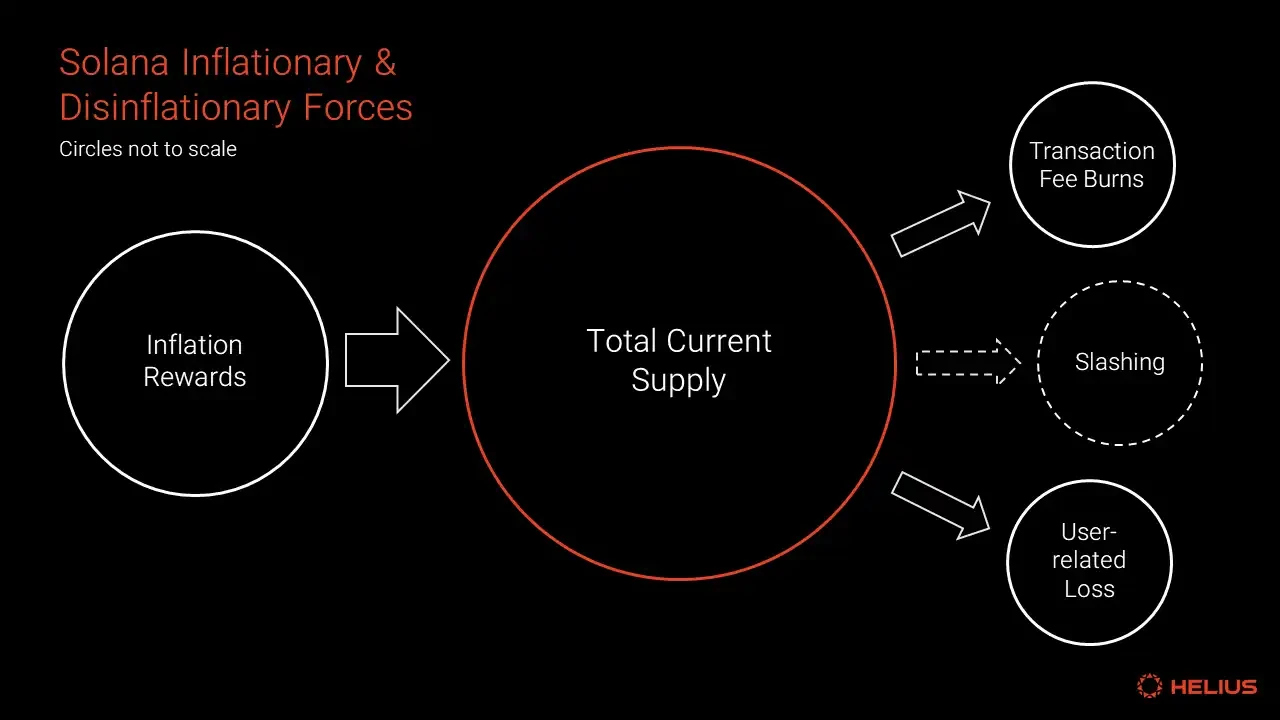
Transaction Fee Burning
All charts and data in this section are based on the dataset provided by Zan from Shinobi Systems. The original data can be accessed through the spreadsheet (click to view). We encourage readers to conduct their own analysis.
Transaction fee burning is the only protocol mechanism that directly removes SOL and reduces the total supply. Previously, the fee burning mechanism included burning 50% of the base fee and 50% of the priority fee for every transaction in each block. The base fee (also known as the signature fee) is fixed at 5,000 lamports per signature, regardless of the complexity of the transaction—typically, each transaction contains one signature. The priority fee is technically optional but has gradually become standard practice. These fees are priced in micro-lamports (one millionth of a lamport) per computation unit.
Priority Fee = Computation Unit Price (micro-lamports) x Computation Unit Limit
With the adoption of SIMD-96, this structure will change. According to the current release schedule, SIMD-96 will be implemented shortly after the Breakpoint conference in 2024, alongside Agave 2.0 implementation. In the future, 100% of the priority fee will go to the block producers, eliminating their incentive to transact off-chain.
Starting from Epoch 544 on December 10, 2023, there has been a noticeable inflection point in the priority fee burning. The highest total fee burning occurred in Epoch 590 (starting on March 18, 2024), with a total of 13,212.31 SOL burned. Over the most recent 100 epochs, the average total fee burning per epoch is 5,372.16 SOL.
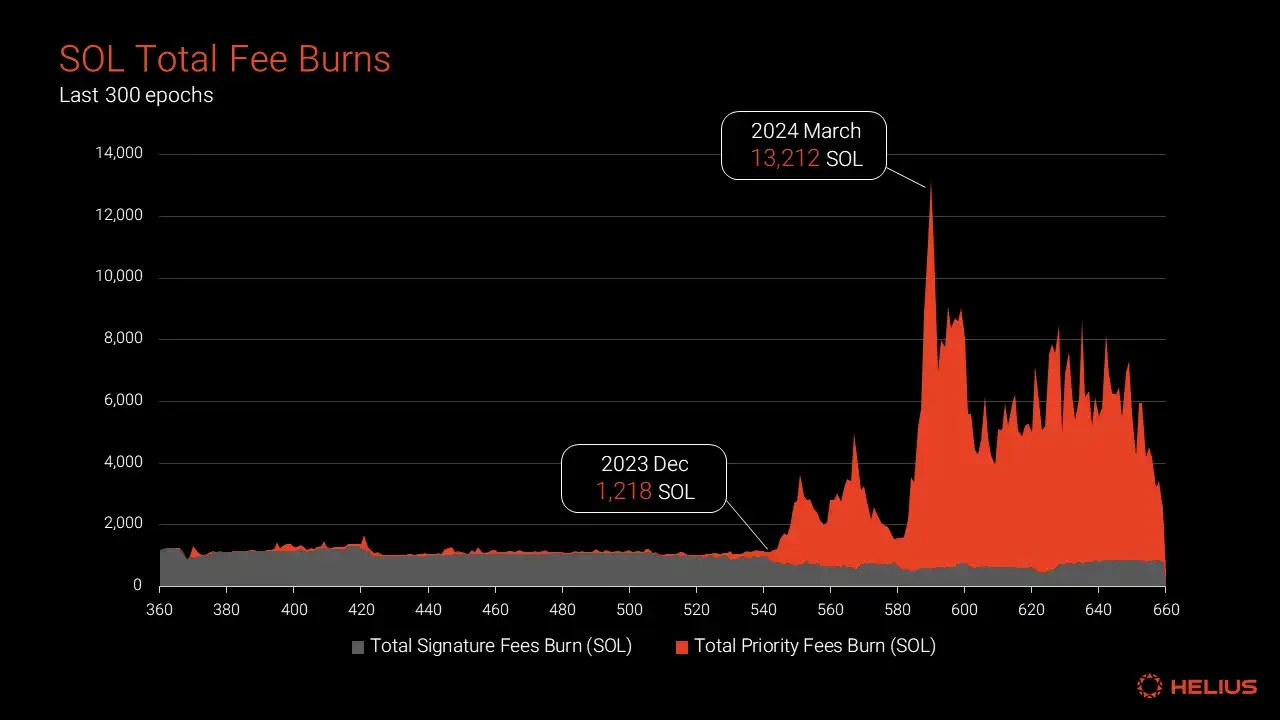
Total SOL fee burning (priority + signature fees) counted by epoch before SIMD-96
Starting from Epoch 546 on December 14, 2023, fee burning first exceeded 1% of the total staking rewards and peaked at 7.8% in Epoch 590 starting on March 18, 2024. Over the most recent 100 epochs, the average fee burning as a percentage of total staking rewards is 3.2%. However, if we apply the SIMD-96 rule change (removing priority fee burning) to simulate the fee burning scenario, the total amount burned at any point in Solana's history would never exceed 1% of the total staking rewards. Implementing the changes from SIMD-96 in the most recent 100 epochs would increase the total supply by 2.81% (e.g., an epoch with a net inflation of 5% would rise to 5.14%). Previously, community members estimated that this increase in total supply might be slightly higher, at 4.6%.
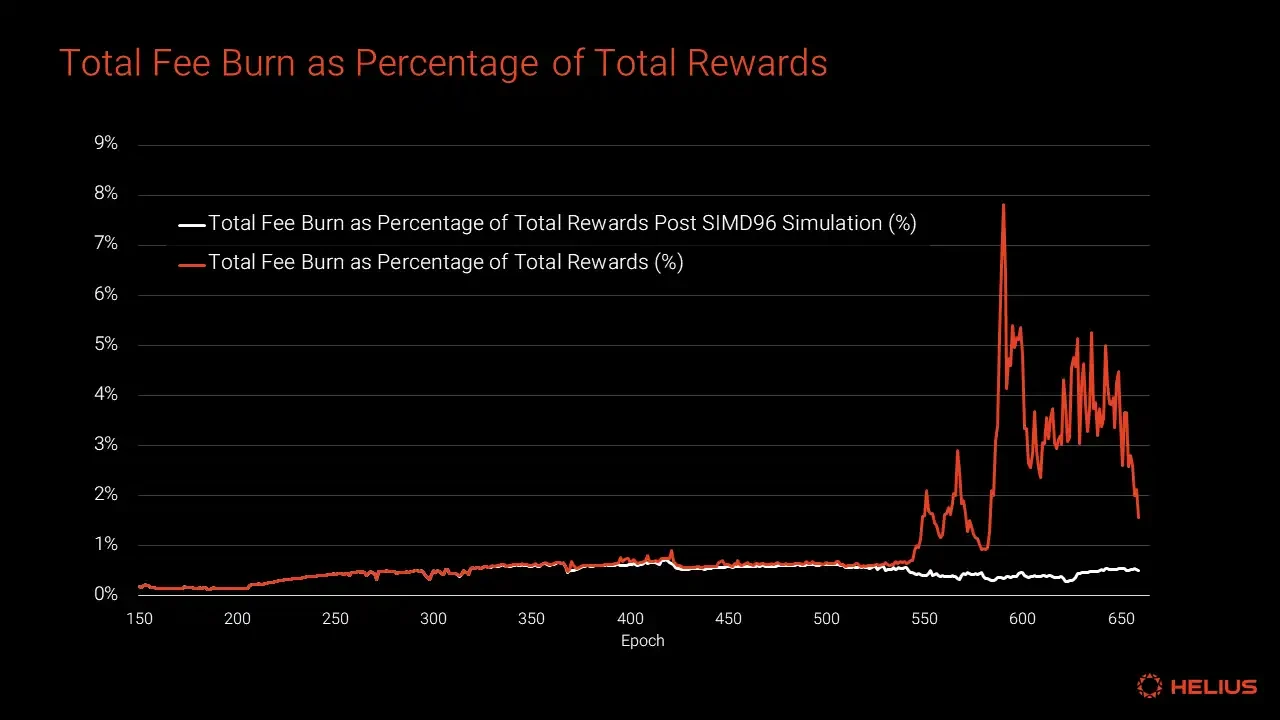
Analysis of net inflation (defined as total staking rewards minus total fee burning) for each epoch indicates that the new issuance of SOL tokens far exceeds the impact of token burning in the protocol. Furthermore, with the implementation of SIMD-96, the already limited impact of token burning will be further reduced, becoming almost negligible.
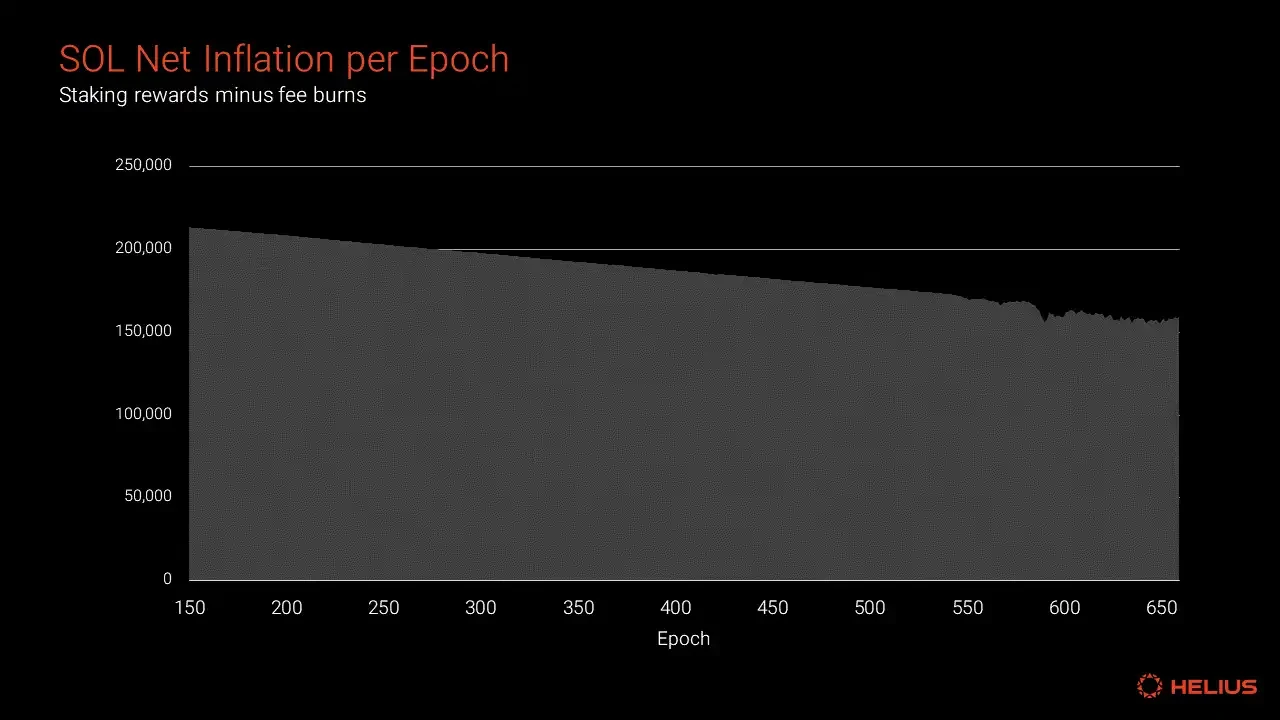
In the discussion on SIMD-96 on the Solana forum, the comment from 7LayerMagik (Overclock validator) summarized the impact of SIMD-96 on inflation:
"This SIMD makes it more difficult for transaction fees to generate significant deflationary pressure. While transaction fee burning may currently be overshadowed by the issuance of inflationary tokens, fee burning could still have a greater impact in the future—however, this SIMD makes them almost inconsequential in this regard. Whether deflationary pressure is important remains to be discussed."
One important point to note is that the initial decision to burn 50% of the priority fee was not subject to formal governance or consensus processes, unlike the inflation schedule, which underwent community voting.
User-Related Losses
User-related losses is a broad term that refers to the unfortunate permanent loss of SOL through user errors, security incidents, program vulnerabilities, or loss of private keys. For example, previous estimates showed that approximately 0.76% of the total Ethereum supply (912,296.82 ETH), valued at around $23 billion at the time of writing, has been permanently lost due to similar events. More than half of the losses can be attributed to a security incident in 2017, which resulted in over 500,000 ETH being frozen.
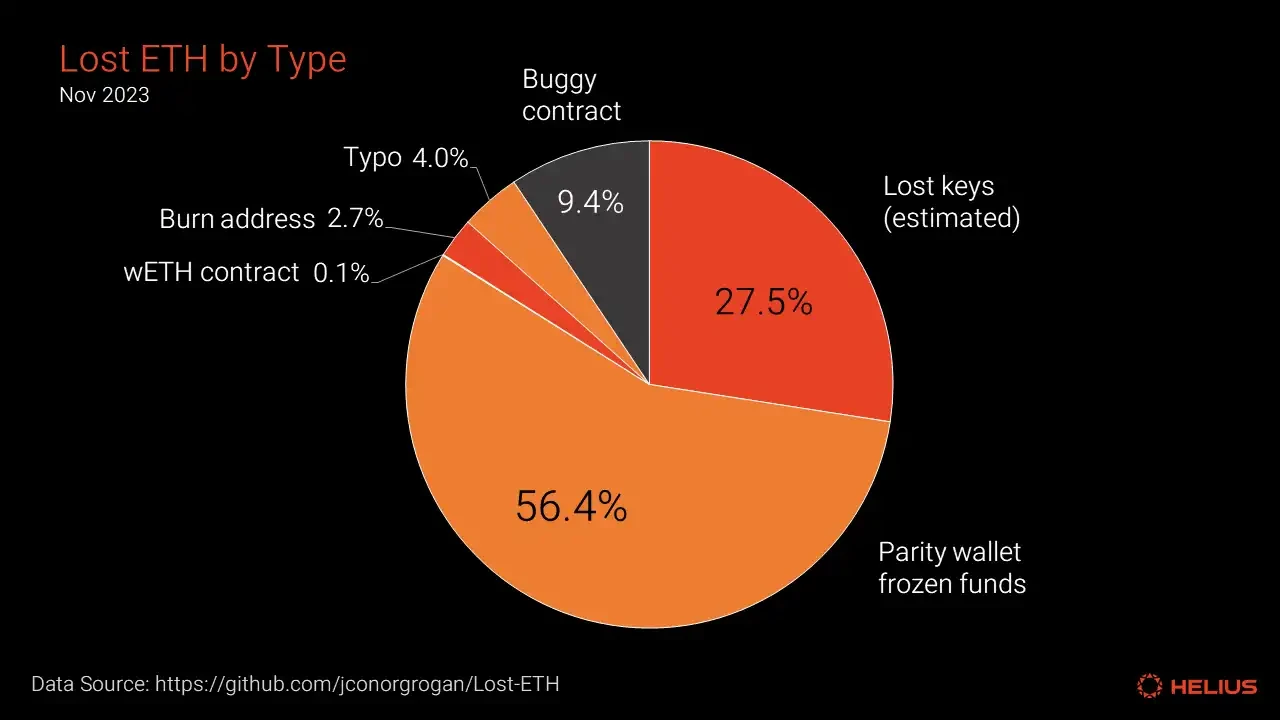
Categorized lost ETH (source)
Bitcoin is another significant example with available data. Approximately 1.75 million Bitcoin wallets have been inactive for ten years or more, collectively holding 1,798,681 BTC, valued at around $106.3 billion at the time of writing. This data does not include approximately 30,000 wallets believed to be associated with Bitcoin's creator, Satoshi Nakamoto. These long-dormant tokens account for 8.3% of Bitcoin's total fixed supply of 21 million. While not certain, given the many high-profile cases involving users being unable to access their Bitcoin due to lost or forgotten keys, many of these tokens may have been permanently lost.
As Solana network activity grows, user-related losses will inevitably occur. Long-term secure storage of private keys is challenging, and even professional wallet service providers can make mistakes. Additionally, token holders may fail to transfer their private keys before passing away, resulting in token loss.
Punitive Reductions
Although such a mechanism was considered in the early economic design of Solana, there is currently no programmatic punitive reduction in place. The official documentation describes a manual social slashing process that has been tested on the testnet:
"…the network will pause after a security violation. We can analyze the data, identify the responsible party, and recommend slashing their stake upon restart."
For completeness, we include slashing in the analysis as one of the known ways in Proof of Stake networks to reduce token supply. However, due to the infrequency of such occurrences, the impact of slashing on the overall inflation rate may not be significant. Furthermore, some preliminary proposals for automatic slashing suggest freezing staked tokens for several epochs, preventing them from earning rewards, rather than directly reducing the principal. Therefore, these methods may not actually reduce the token supply in practice.
Leasing Mechanism
Although rent is not a true deflationary force, it is still worth discussing in this context. All Solana accounts must hold a minimum "rent-exempt" SOL balance to pay for storage fees and ensure the account remains active in the validator's memory. This minimum balance requirement is proportional to the amount of stored data and can be fully refunded when the account is closed. Solana's rent rates are network-wide and set as a constant amount of lamports per byte per year at runtime, for example, the rent-exempt balance for a standard user token account (associated token account) is 0.002 SOL. This mechanism helps reduce state bloat and incentivizes users to close unused accounts.
Many programs automatically manage rent refunds for users, and there are various applications to help users reclaim rent from unused accounts, such as PooperScooper, Sol Incinerator, and Hedgehog Hub. However, despite these tools, many Solana users still have limited understanding of the rent mechanism. Additionally, some applications fail to provide users with a simple way to reclaim rent.
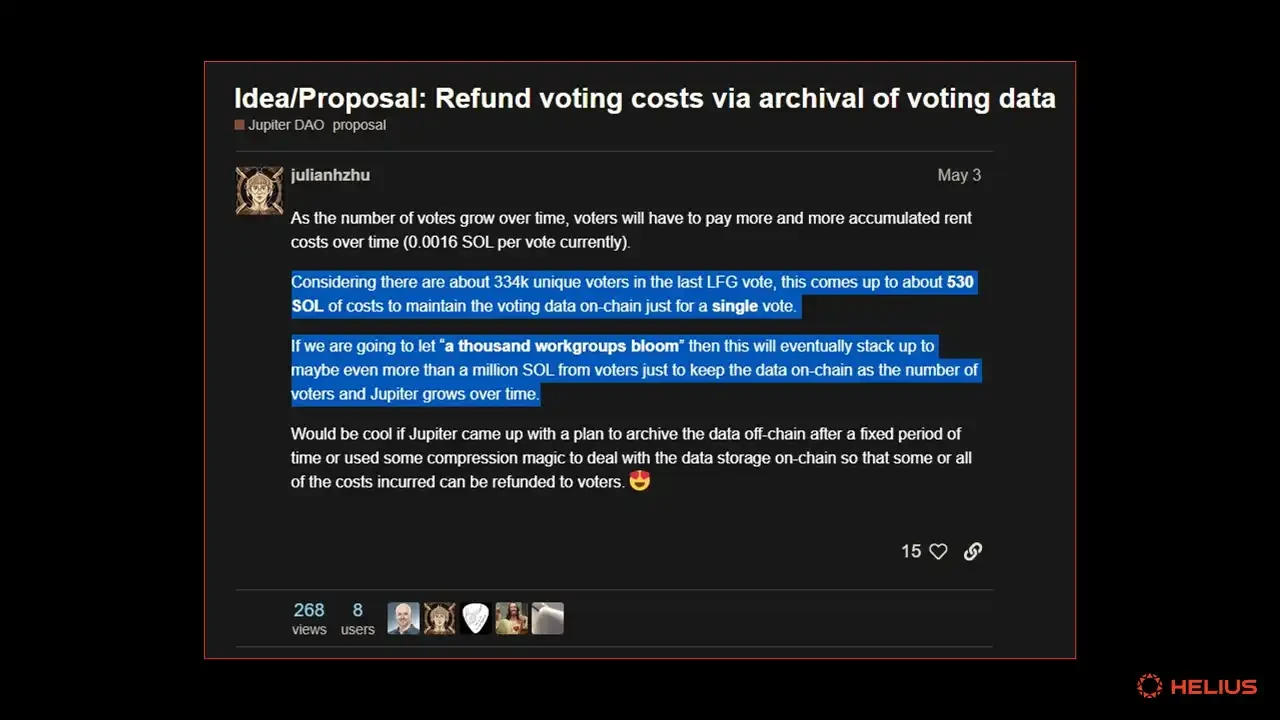
A post on the Jupiter DAO forum points out the issue of high rent costs resulting from large-scale on-chain DAO voting.
Each rent payment represents a temporary lockup of SOL, and if not reclaimed, it constitutes a form of user-related loss. While the individual rent amount for each account is very small, when considering all applications and users, these small losses can accumulate into a significant total amount. In the future, ZK compression technology may partially alleviate these high account costs.
Future: Time for Change?
"This is just some numbers moving around in a black box… The current inflation schedule might indeed be too high. Even if it were reduced by a factor of ten, everything would be fine. I think in the end, these costs aren't actually that important." — Anatoly Yakovenko (Source)
In this final major section, we will first briefly quantify the remaining unlock schedule for non-circulating supply. Then, we will discuss arguments for modifying Solana's token issuance, including the concept of "issuance as network cost," the inefficiency of inflation as a tax, downward price pressure from inflation, the punitive effect on network usage, and the rise of alternative validator revenue sources. After that, we will explore some practical ways to adjust the inflation schedule and reduce inflation.
Future Unlocking of Non-Circulating Supply
Over the past three years, Solana's locked staking unlock rate has been relatively stable, decreasing from a peak of 96 million SOL in September 2021 to 48 million SOL in September 2024, a 50% overall decrease.
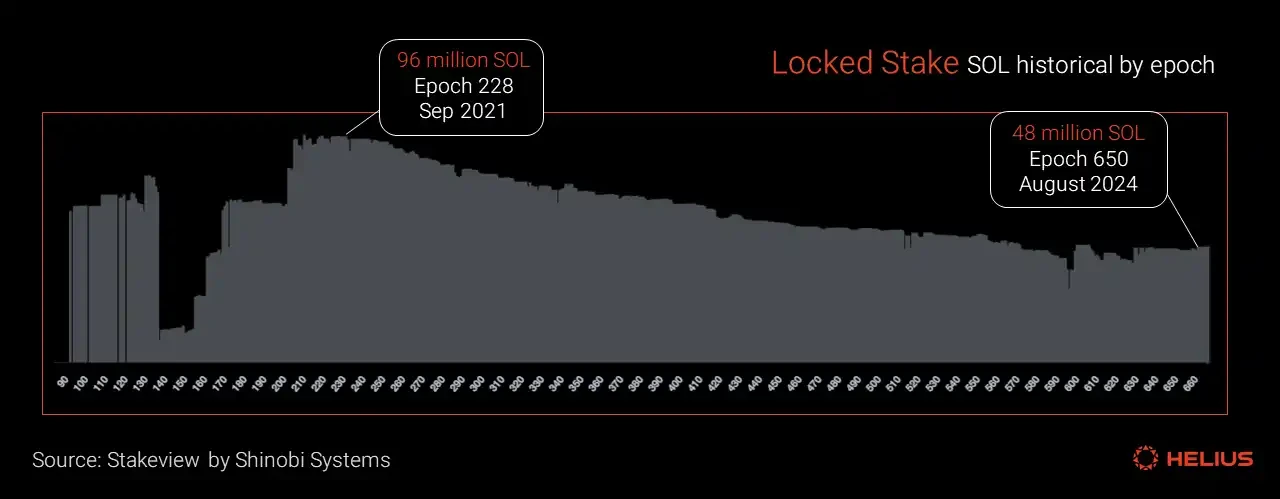
Historical data on locked staking (source)
Currently, at least 43.5 million SOL tokens are still locked in staking accounts, accounting for 7.5% of the current supply. This includes 41 million SOL tokens sold to large industry entities (such as Galaxy Digital and Pantera) during the FTX asset bankruptcy proceedings earlier this year. Some companies, such as Neptune Digital Assets, publicly announced their purchase details—Neptune purchased 26,964 SOL at a price of $64 per token. 20% of these tokens will unlock in March 2025, with the remaining portion unlocking linearly on a monthly basis until early 2028. This unlocking schedule aligns with on-chain locked staking account data (see chart).
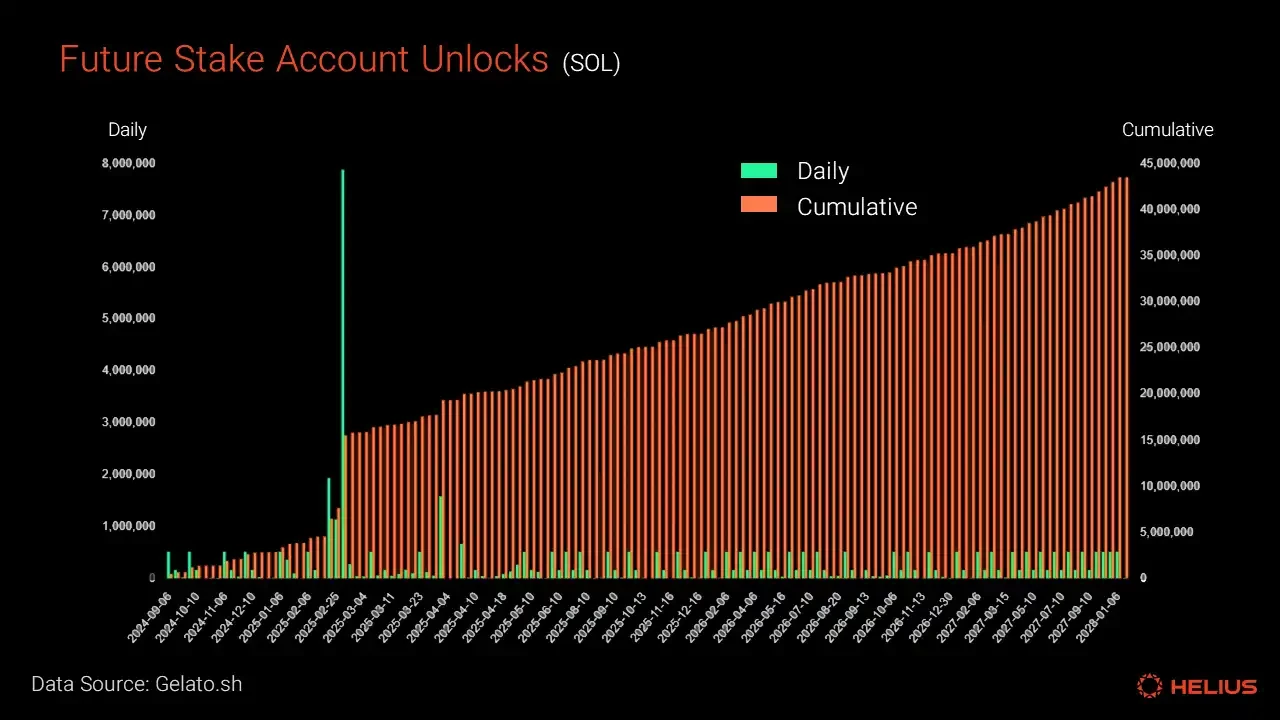
Future unlocking status of staking accounts (data source)
In the following sections, we will present several reasons for adjusting Solana's token issuance.
Issuance as Network Cost
A common argument against Proof of Stake (PoS) inflation is that inflation is an explicit cost to the network, and token issuance constitutes a part of the blockchain's "profitability," calculated as: Profit = Burn - Issuance. However, this argument is incorrect. Inflation cannot be understood in this way; it is actually just a redistribution of wealth among all token holders and stakers, with all token holders having an equal right to receive this cash flow.
The only network cost associated with inflation is a portion of value flowing from stakers to validators, which is subsequently used to cover operational expenses, as shown in the following diagram.
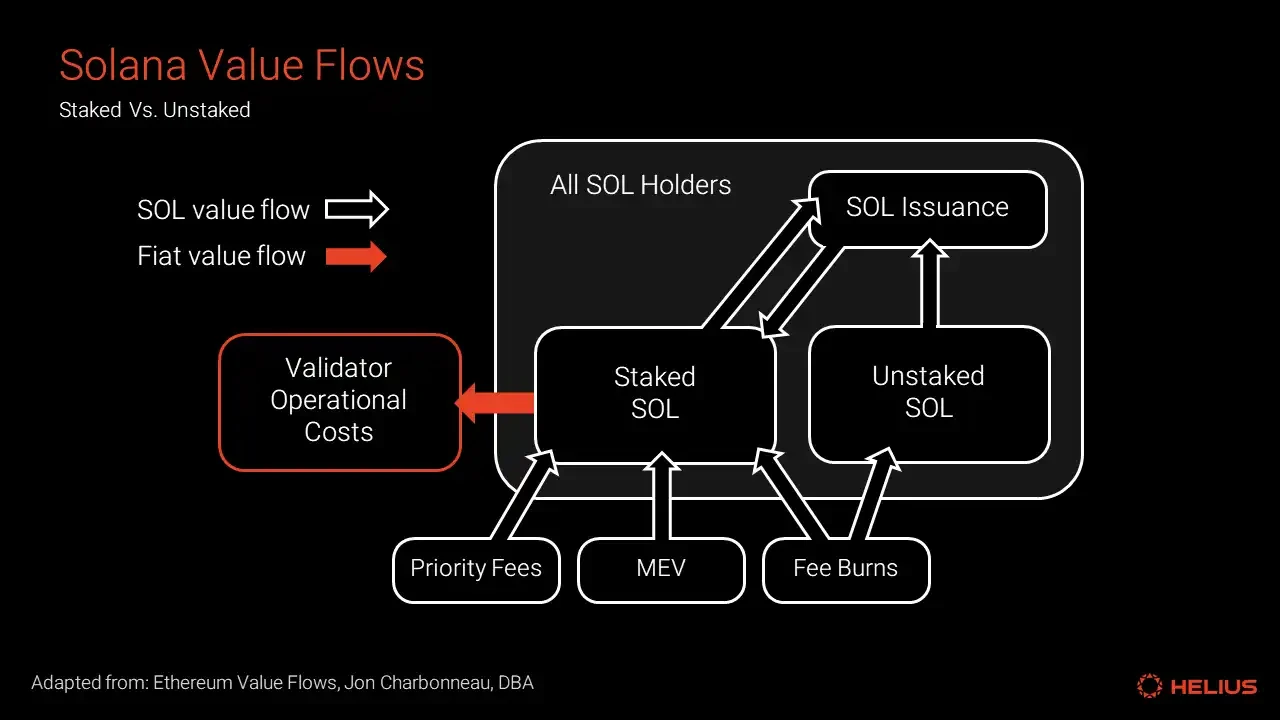
Solana value flow, adapted from this source
We can begin to quantify this value flow by looking at the total staking rewards commission paid to validators, which is currently approximately 44,000 SOL per epoch. However, this data is significantly inflated due to the presence of private self-staking validators with a commission rate of 100%.
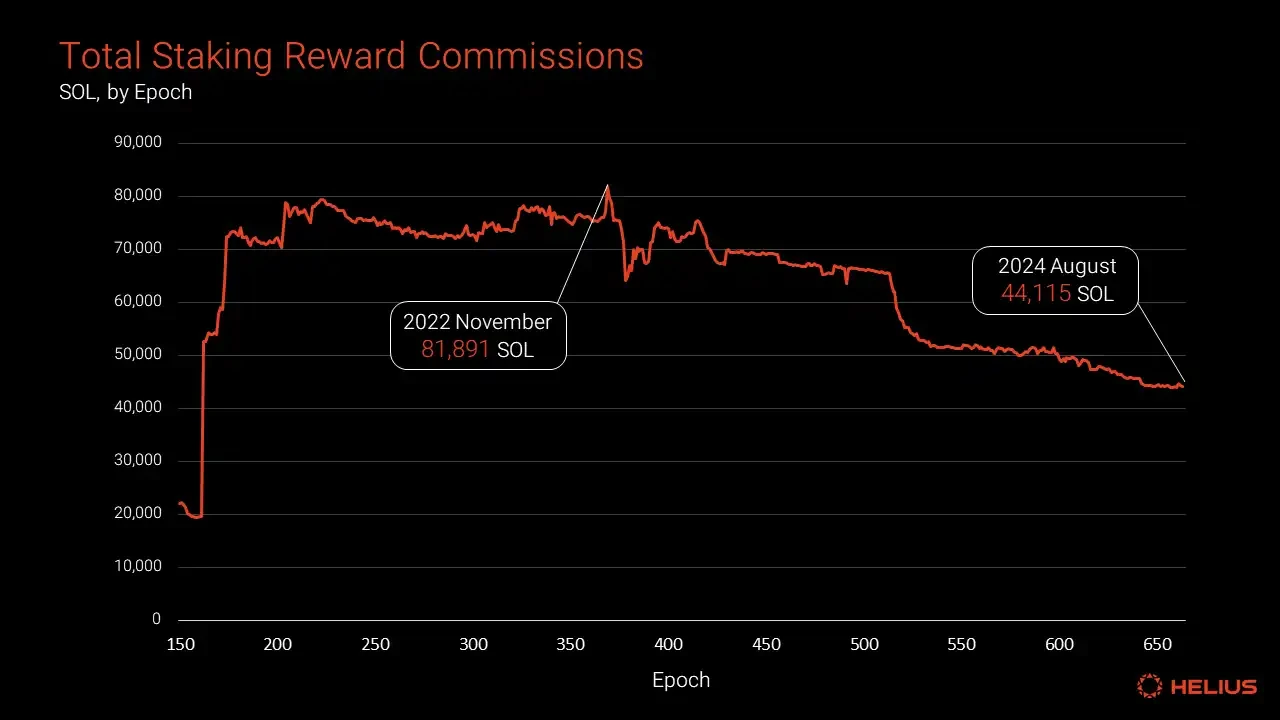
Total staking rewards commission paid to validators by epoch
Inefficiency as Tax
In many jurisdictions globally, receiving inflation rewards in the form of additional tokens is considered a taxable event, similar to stock dividends. Such income is typically subject to income tax upon receipt. This tax burden may lead to stakers having to sell a portion of their tokens each year to pay taxes, resulting in continued selling pressure. Quantifying this impact is extremely difficult due to the complexity and vast differences in global tax laws. Even within the same jurisdiction, individual tax liabilities may vary significantly. Additionally, due to the permissionless nature of staking, it is difficult to trace token ownership back to individuals.
A blog post by Jito mentions that non-custodial Liquid Staking Tokens (LST) on Solana may help reduce this tax burden:
"Non-custodial LST on Solana may allow users to earn rewards without triggering a taxable event, as the quantity of LST tokens in the wallet does not change (consult a financial professional for advice specific to your situation)."
However, the conversion between SOL and staked SOL itself may also constitute a taxable event. Furthermore, as discussed in a previous SFDP report, the overall adoption of LST on Solana is still relatively low. Currently, 94% of staked SOL is native staking, with only 6% of SOL (24.2 million SOL) staked through liquid staking, compared to 17 million SOL at the beginning of 2024 and 12.4 million SOL a year ago (a 95% annual growth rate).
Downward Price Pressure
Inflation can lead to long-term, sustained downward price pressure, distorting market price signals and hindering fair price comparisons. A traditional financial market analogy can explain this: PoS inflation is akin to a publicly traded company conducting small-scale stock splits every two days. Charts, dashboards, casual observers, and retail investors typically do not consider the impact of inflation when analyzing.
A favorable price chart is the best advertisement for an ecosystem, applicable not only to traders but to all ecosystem participants. In the psychology-driven market of cryptocurrency, price serves as a coordination point and a signal of ecosystem health. Strong price performance is always the best marketing—price drives the narrative.
Consider two different scenarios. I currently hold 100 SOL, each worth $100, with a total value of $10,000.
Scenario A: I choose to stake these SOL and wait for a year. Despite a 5% price drop during the period, as a staker, I receive a 12% inflation reward. I now hold 112 SOL, each worth $95, with a total holding value of $10,650.
Scenario B: I choose not to stake. The price of SOL has risen by 5% over the year. I still hold 100 tokens, each worth $105, with a total holding value of $10,500.
In absolute terms, Scenario A yields a slight gain. However, Scenario B, due to the price increase, would feel more satisfying, even though this perception is irrational. The psychological impact of price is often overlooked or underestimated because these factors are inherently difficult to quantify. People tend to make decisions or policy judgments based on quantitative data, even though qualitative factors may be equally or more important.
Punitive Effect on Network Usage
Proof of Stake (PoS) inflation effectively penalizes users who actively use SOL on the chain, such as participating in liquidity pools, NFT trading, or placing orders—activities that a growing network should encourage. While the mature and robust Liquid Staking Token (LST) infrastructure on Solana can mitigate these negative effects by allowing active use of SOL without dilution, it also introduces additional costs. These costs include friction in user experience, dispersion of liquidity between different tokens, potential slippage when exchanging between LSTs, and the burden of understanding the staking mechanism to protect oneself from the indirect costs of dilution.
Respected industry commentators have pointed out that most native tokens should be productive, and the ideal staking rate should be close to 10%.
Balancing High State Costs
The downward price pressure from inflation may help alleviate Solana's high state storage costs. These costs are set when the price of SOL is far below the current levels. Developers in the Solana community often complain about the high costs of deploying programs on-chain, often requiring hundreds or even thousands of SOL.

Opinions expressed by members of the Solana developer community (X platform post)
Feasible Alternative Revenue Sources for Validators
As mentioned in our previous SFDP report, validators have three main revenue sources: MEV (Maximal Extractable Value) commissions, block rewards, and staking rewards commissions.
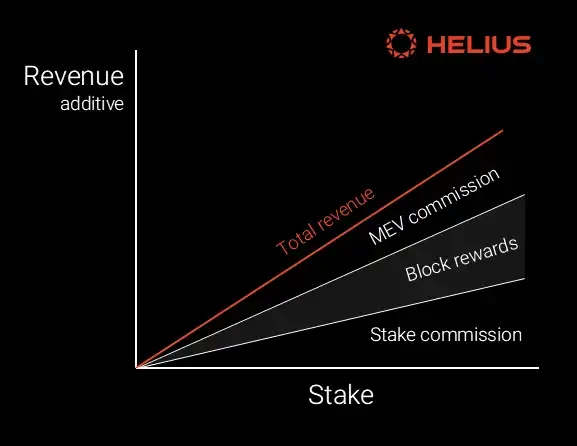
Validator revenue sources depend on their staking situation.
Since December 2023, MEV commissions and block rewards have significantly increased. In the fee burn section of the report, we discussed priority fees data. The following chart shows the growth of MEV.
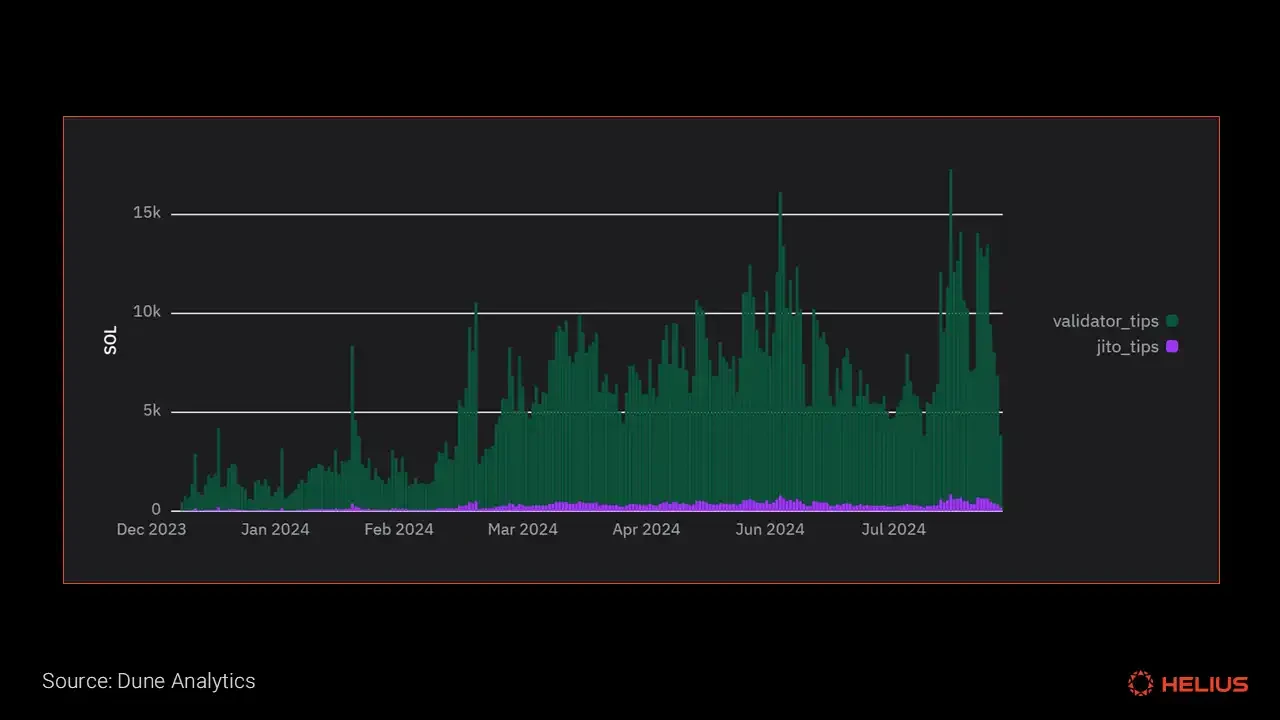
Growth of Jito's daily tips in 2024 (dashboard)
However, it is easy to identify the group of validators that benefit the most from high inflation, including highly staked exchange validators serving off-chain retail users and some institution-focused validators. These validators typically have relatively high commission rates, such as Coinbase (8%), Binance Staking (8%), Kraken (100%), and Upbit (100%). Examples of institutions include Everstake (7%), Twinstake (10%), Hashkey (7%), and P2P (7%).
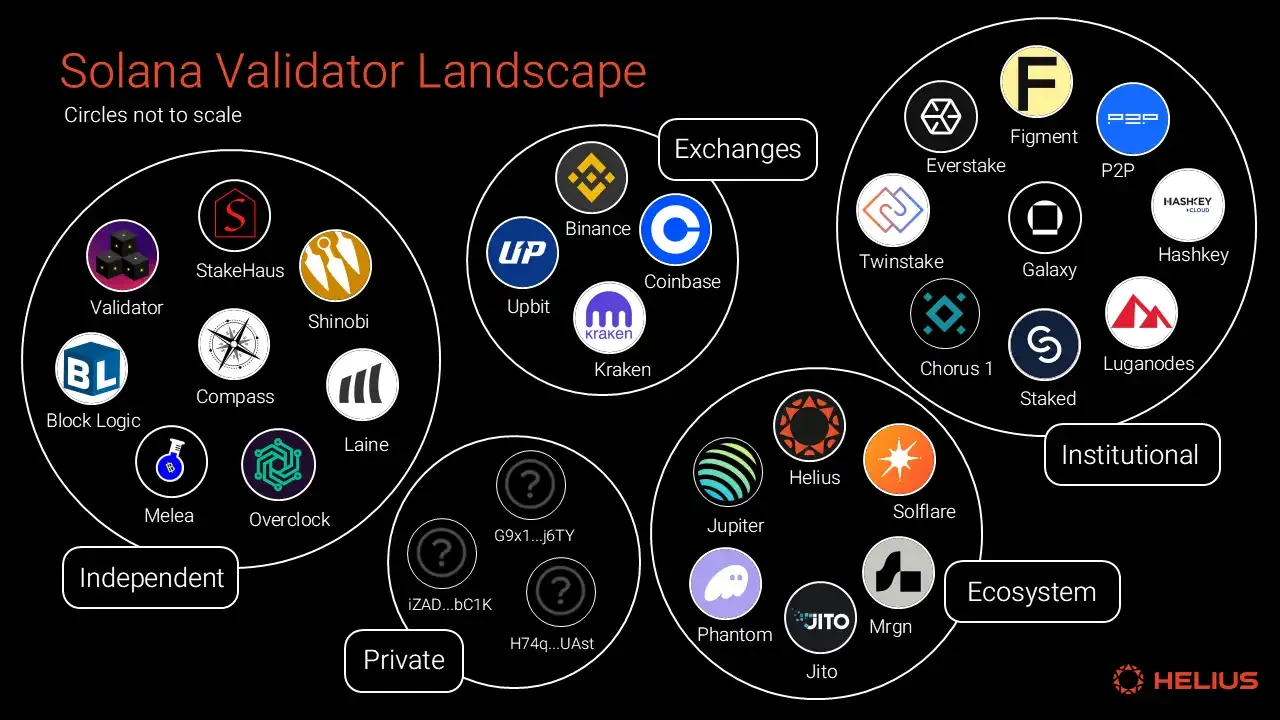
On the other hand, ecosystem teams (e.g., Jupiter 0%, Solflare 6%, Mrgn 0%, Helius 0%) and independent validators (e.g., Melea 0%, StakeHaus 0%, Shinobi Systems 3%, Laine 5%, Solana Compass 5%) typically exhibit lower commission rates and benefit less from inflation commissions. This is because these validators, especially the long-tail independent validators, must compete for market share by targeting on-chain active staking that responds to Annual Percentage Yield (APY). These stakers are the most price-sensitive and seek the highest returns.
Overall, alternative sources of income beyond inflation commissions have significantly increased in 2024. However, whether these alternative income sources can maintain such high levels in the long term remains to be seen. Additionally, the group of validators benefiting the most is those with higher fees, such as exchange and institutional validators, which disproportionately occupy a supermajority and superminority share of the network.
This section uses data from Solana Beach as the source of staking commissions. For further exploration of the validator landscape, please refer to our previous SFDP report.
Staking Incentives
Anatoly Yakovenko (source) has stated: "Rationally, you need some stakers to choose the quorum. The quorum doesn't lead to security violations like network halts, but in a well-managed system, the quorum doesn't actually do much. You need some incentives for people to stake and choose the quorum. You also need some punishment mechanisms, like slashing, to make sure people are choosing the quorum well, and that's it."
Inflation rewards encourage users to stake their tokens, thereby enhancing the network's security. Although Solana's current staking rate is relatively high, reaching 65%, significantly reducing inflation rewards may change the balance of staking and could lead to some unexpected consequences, such as a decrease in governance participation.
Modifying the Inflation Schedule Model
"One of my guiding principles has always been to either double a number or cut it in half. Don't waste time adjusting by 5%, then another 5%, and then another… Just double it and see if it has the effect you're looking for." —Sid Meier, creator of the game "Civilization". Source: "Sid Meier's Memoir".
In this section, we will explore several hypothetical scenarios by adjusting three key parameters of the Solana inflation schedule to modify the inflation rate. This analysis aims to provide a clearer understanding of the impact of each parameter on the overall inflation rate.
Current parameters:
Initial inflation rate: 8% Decay rate: -15% Long-term inflation rate: 1.5%
These projected data can be found in this spreadsheet.
We will explore the following scenarios:
Scenario A: Doubling the decay rate from -15% to -30% Scenario B: Halving the long-term inflation rate from 1.5% to 0.75% Scenario C: Immediately halving the current inflation rate from 5% to 2.5% Scenario D: Halving the current inflation rate, doubling the decay rate, and halving the ultimate inflation rate
Each scenario aims to test the long-term impact of these key adjustments on the overall inflation rate, helping to understand how different strategies change the inflation dynamics of SOL.
Based on the calculations, the current inflation rate has been approximately 5% since September 2024, with a total supply of 5.84 billion SOL, simulated for the next eight years. As previously shown, the token burn mechanism of SIMD-96 has minimal impact on the supply, so this factor is ignored in this analysis. For simplicity, inflation is calculated annually, and an epoch year is considered equivalent to a standard year. Additionally, the baseline with the current inflation schedule unchanged is provided.
Halving the long-term inflation rate (Scenario B) would have almost no impact on inflation over the next eight years. This change would only reduce the total supply by 1 million by September 2032. Doubling the decay rate (Scenario A) would result in a total supply of 6.78 billion after eight years, a 5.3% decrease from the baseline. Immediately halving the current inflation rate (Scenario C) would result in a total supply of 6.64 billion after eight years, a 7.3% decrease from the baseline. Finally (Scenario D), the combination of halving the current inflation rate, doubling the decay rate, and halving the ultimate rate would result in a total supply of 6.29 billion after eight years, a 12.2% decrease from the baseline.
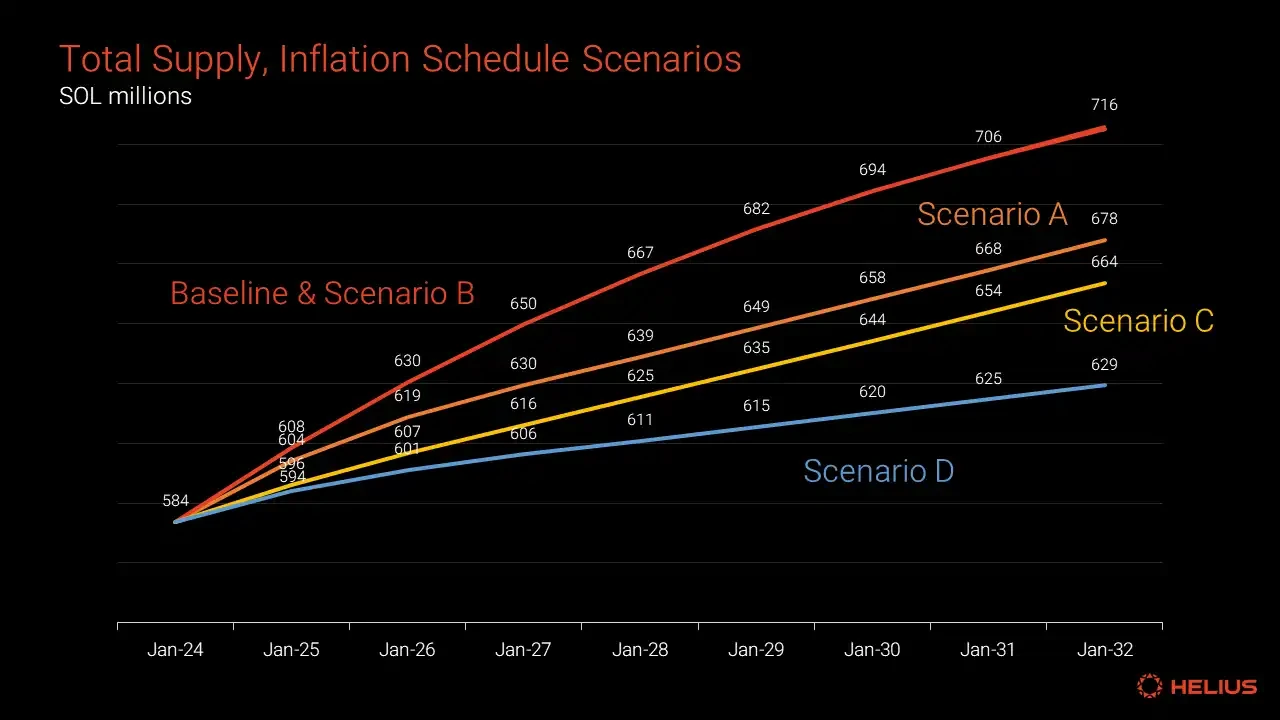
Predicted total supply of Solana based on four hypothetical changes to the inflation schedule.
With these increased supplies, we can simulate their expected impact on the price of SOL tokens, assuming other variables remain constant (i.e., ceteris paribus), by keeping Solana's fully diluted valuation (i.e., the current total supply) constant. For illustration, we assume the initial price of SOL tokens is $150.
In our baseline scenario, the current inflation reward schedule leads to downward price pressure, resulting in a 18.5% decrease in token price over eight years, down to $122.25. Doubling the decay rate (Scenario A) would result in a 13.93% decrease in token price over eight years, down to $129.10. Immediately halving the current inflation rate (Scenario C) would result in a 12.07% decrease in token price over eight years, down to $131.90. Finally (Scenario D), the combination of halving the current inflation rate, doubling the decay rate, and halving the ultimate rate would result in only a 7.26% decrease in token price over eight years, down to $139.10.
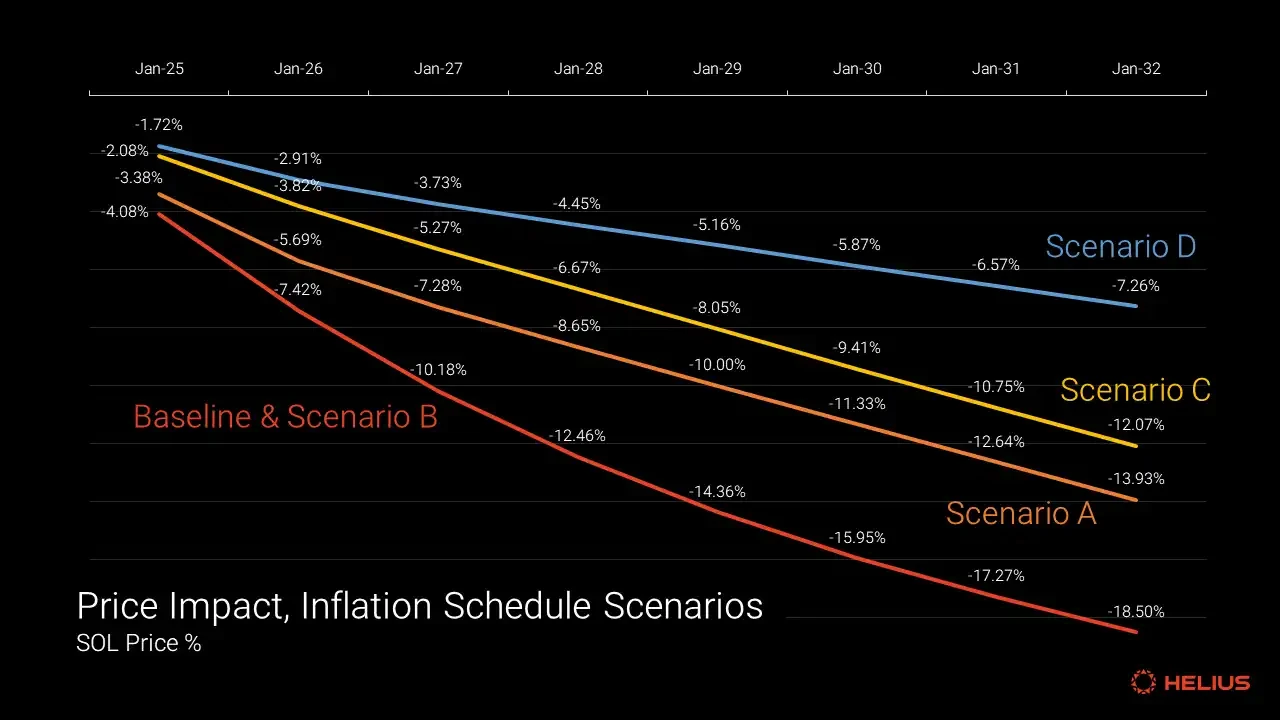
Predicted impact on Solana price based on four hypothetical changes to the inflation schedule.
A further direction for future research is to analyze the impact of these changes on the inflation commissions collected by long-tail independent validators and the overall incentive mechanism for continued staking by users.
Conclusion
This report has explored Solana's inflation schedule and token issuance mechanism from past, present, and future perspectives. We have analyzed the current mechanism used for calculating and distributing inflation and identified the counterforces to reducing inflation. Additionally, we have evaluated the potential impact of SIMD-96, discussed the main arguments for adjusting the inflation rate, and analyzed changes to the parameters of the inflation schedule through modeling assumptions.
The token issuance of Solana has been subject to much scrutiny and it is hoped that this report provides clear answers to some key questions. Through these analyses, we aim to foster more informed discussions and contribute to constructive dialogue for driving positive change.
免责声明:本文章仅代表作者个人观点,不代表本平台的立场和观点。本文章仅供信息分享,不构成对任何人的任何投资建议。用户与作者之间的任何争议,与本平台无关。如网页中刊载的文章或图片涉及侵权,请提供相关的权利证明和身份证明发送邮件到support@aicoin.com,本平台相关工作人员将会进行核查。




